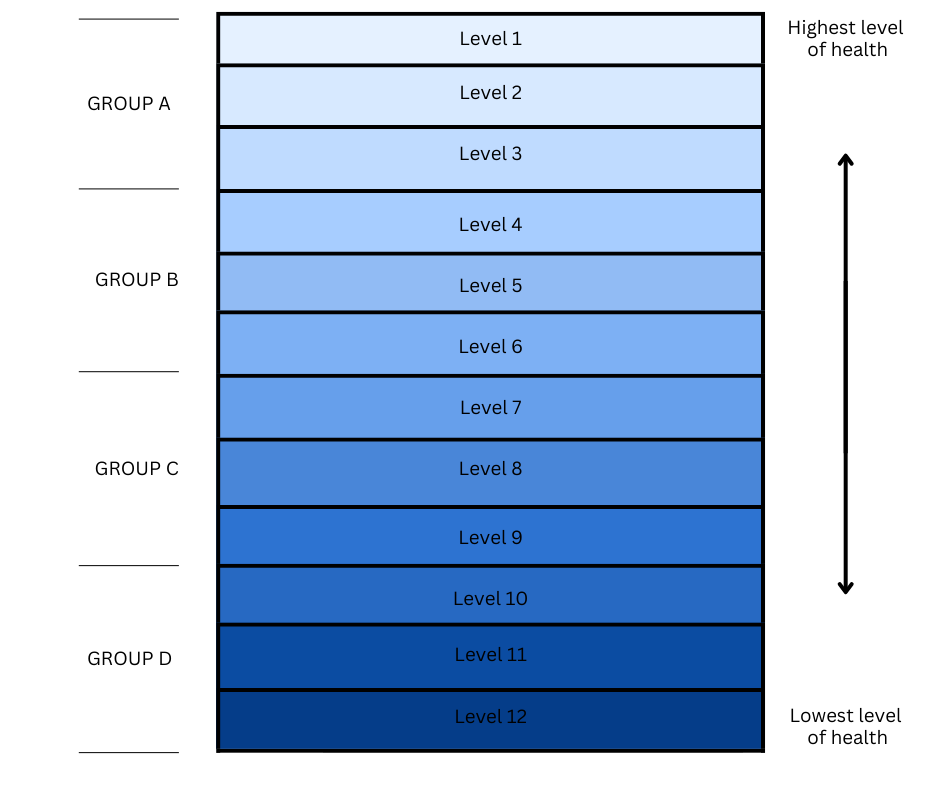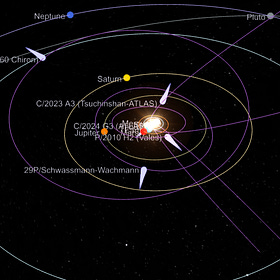First appointment, 2019
A sixteen week old male infant suffering gastro-esophageal reflux (GER) - regurgitation of curdled milk 15 to 60 minutes after each feed, which started at birth.
‘Baby B’ is breast fed, alert, strong, growing well, and is large for his age. He has mild ‘dry skin’ - on his back - from four weeks old. Aged eight weeks, lingual frenotomy was performed due to ankyloglossia (tongue tie). He has heavy perspiration cervical (neck) region. Sleeps best with arms raised. A very happy, engaged, busy baby.
Background His mother took no drugs or vaccines during pregnancy. Unmedicalized home birth. Family medical history of eczema, breast cancer, depression, and herpes.
Level of Health Was estimated as Group A; Level 1. These are the healthiest individuals whose susceptibility to acute infections is limited. Clean air and healthy lifestyle individuals. NB: Infancy is not a Group A indicator.
The Ladder of Health by George Vithoulkas1

Levels of Health theory enables classification of an individual’s overall disease state and provides the homeopath with an analytical tool which can be used in a number of ways including assessment of the reaction to the remedy, and prognosis. The working hypothesis is that an individual can be categorized into one of Twelve Levels, found within Four Groups A, B, C and D, as represented by the Ladder of Health (Figure 1).
-
Selection of ‘Baby B’s’ symptoms (represented as rubrics) with grading
Repertorization results ‘Baby B’ 2019
Repertorization is a scientific way of collating an individual’s symptoms, found as rubrics in the repertory, to narrow down a few remedies which may be most similar.
The whole system of homeopathy is based mainly upon the principle that the cure of a disease is accomplished by drugs that are capable of producing, in a healthy individual, similar symptoms (suffering) to those of the disease to be treated.2
-
Remedies for investigation
CALCAREA CARBONICA - Has the keynote of impaired nutrition manifesting in this case as vomiting of milk, spitting up milk. Profuse and easy perspiration in the cervical region. Musculoskeletal system particularly affected (ankyloglossia).3
SILICEA - Intolerance for breast milk in infants, with failure to thrive, and perspiration of the scalp, is not seen in this case.4
AETHUSA - Tendency to vomit milk easily but aversion to milk and general weakness in children is not seen in this case.5
-
Prescription & Posology, 2019
Calcarea carbonica, 10M, one (liquid) dose to begin.
A 10M potency was selected due to the high - Group A; Level 1 - Level of Health estimate. As a generalized rule, a potency over 1M is selected for individuals belonging to the higher levels of health.6
Mum happily reported two weeks’ post the dose regurgitation of curdled milk was no longer an issue for Baby B.
The second appointment, 2020
At 13months of age, ‘B’ who had been developing and teething without issue suffered a pin worm infestation.
‘B’s presenting symptoms
Repertorization results ‘B’ 2020
‘B’ has a Calcarea carbonica 'sub layer' as evidenced by his lifelong tendency to heavy cervical perspiration, and sleeping posture of arms over head. The need for Cina here shows ‘B’ does not belong to Group A; Level 1 (difficult to accurately define in a wee baby!,) as initially evaluated.
Vithoulkas makes reference to the fact that around 40% of babies require Calc carbonica, and that as the child grows the need for calcium decreases, resulting in one of three outcomes.7
Applicable to ‘B’ is likely a calcium absorption problem which was not corrected and therefore accompanied by new layers of disease disturbance, giving rise to subsequent 'layers of disturbance 'and invoking the idea of an underlying miasm.
Miasm starts to take effect as descent through the Levels of Health begins (Fig;1), the individual becoming overloaded with hereditary predispositions begins the slow progression towards chronic disease.8
Level of Health Due to the appearance of an acute disease, and taking into consideration that Calcarea carbonica 10M resolved the gastro-esophageal reflux, and that ‘B's symptoms clearly point to Cina as the specific remedy - I placed ‘B’ within Group A; Level 2 (Fig;1) who will experience occasional acute diseases with high fever, with the remedy clearly indicated.9
Prescription & Posology, 2020
Cina, 10M, one (liquid) dose to begin.
The pin worm associated symptoms of aggression, bruxism, and rectal itch returned in Dec 2020 so the dose was again repeated to good effect.
No report of aggravation after either dose of Cina 10M supports ‘B’s Group A; Level 2 classification - as does the fact that after each dose of Cina ‘B’ resolved all of the symptoms it was originally prescribed for10 - as outlined in Observation 2 (Figure 2).

Observation 2: The person feels much better in every aspect, but there is little or no aggravation. This reaction confirms that ‘B’ belongs to Group A, Level 2 (Fig;1) with an imperceptible aggravation, followed by a recovery of several months, followed by no return of pin worm associated symptoms for 15months after administration of the second dose of Cina.11

The third appointment, 2021
Both of ‘B’s parents were fired from their jobs in 2021 due to not taking the mandated COVID-19 mRNA Biological Injection, the associated upheaval from which is the suspected reason for ‘B’s development of the following symptoms for which Antimonium crudum 1M was prescribed.
‘B’s presenting symptoms
Repertorization results ‘B’ 2021
According to Roger Morrison MD Antimonium crudum can be often difficult to distinguish from Chamomilla12 so much study and questioning must be undertaken to ensure the prescription is correct! This is the reason the 1M was suggested over ‘B’s typical 10M potency.
Antimonium crudum was repeated again for ‘behaviours’ in a 10M at the end of 2022.
B’s case will continue…
Additional helpful reading (case reports)
-
Homeopathy, Cochineal, & Carmine
-
-
-
-
Homeopathy & behavioural coughing? the boy who coughed a year
-
Homeopathy & migraines & iatrogenesis - a case report spanning four years
-
Homeopathy & Apis mellifica A wee case study
-
-
Homeopathy & Vestibular Neuritis a short case study
(I am sure there are more in my archives if you wish to search them out that is..!)
A BIG thank you to you for taking some precious time out of your life to read my works, I am grateful to you for your time, energy and interest! It’s always so cool to be in touch with you so do feel free to drop a comment below or to contact me, Sarah Penrose, direct via my website goodhealthforgreatlife.com
Homeopaths, I am writing so often here at Substack not because I am trying to set myself up as some kind of ‘expert’ when I am far, far from it but because I see the lines of what homeopathy is (& isn’t) becoming more and more blurred as time passes. Evidence Based Homeopathy? is my attempt to educate and always to lead by example.
My second favoured way of learning homeopathy (besides actually prescribing it!,) is reading well put together case reports mostly coming out to us courtesy of The International Academy of Classical Homeopathy who have always kept the science in homeopathy.
We as homeopaths achieve superior outcomes for the people we work so hard to serve when we keep respect for the individual at all times front and centre.
P.S March 2025 marks the beginning of the weekly international Wounded Healer Study Groups for homeopaths which aim to strengthen our resolve as homeopaths so we can be of better service to mankind. And, being secure in the wisdom of a mostly female group - who have historically always been warriors for homeopathy - is a powerful way to build us up as individuals and collectively!
Just like homeopathy, Chiron can be ‘a seed that uses the power of something extremely small to bring about changes in the world around.' !
Homeopathy & Chiron
Heartbreakingly, I have seen many homeopaths become symbols of the archetype of Chiron - wounded healers. I am often in contact (as homeopath, mentor & teacher) with a fair few of these wounded healers whom I’m always, always, wishing to, and trying to, encourage back into homeopathy practice after *Having dedicated years of their lives to the study of homeopathy *Incurring significant investments of their precious time, money and energy *Only to be let down when it comes to their own homeopathy practice
Vithoulkas, G. Levels of Health – the second volume of the science of homeopathy. 4th revised ed. International Academy of Classical Homeopathy; 2022.
Homeopathy & Hahnemann
“Similia Similibus Curentur. ’’
“Let similars be treated with similars. ”
Hahnemann maintained that this is a basic law of cure.
Vithoulkas G. 2012. (3rd ed.) Materia Medica Viva. Cactus grandiflorus to Calcarea sulphuricum. International Academy of Classical Homeopathy. Alonissos. Greece. (First published 1997)
Morrison, R. 1993. Desktop Guide to Keynote and Confirmatory Symptoms. Hahnemann Clinic Publishing. Grass Valley.
Vithoulkas G. 1995. Materia Medica Viva. Abelmoschus to Ambrosia Artemisiae Folia. International Academy of Classical Homeopathy. Alonissos. Greece.
Vithoulkas, G. Levels of Health – the second volume of the science of homeopathy. 4th revised ed. International Academy of Classical Homeopathy; 2022.
Vithoulkas G. 2012. (3rd ed.) Materia Medica Viva. Cactus grandiflorus to Calcarea sulphuricum. International Academy of Classical Homeopathy. Alonissos. Greece. (First published 1997)
Vithoulkas, G. Levels of Health – the second volume of the science of homeopathy. 4th revised ed. International Academy of Classical Homeopathy; 2022.
Vithoulkas, G. Levels of Health – the second volume of the science of homeopathy. 4th revised ed. International Academy of Classical Homeopathy; 2022.
Vithoulkas, G. Levels of Health – the second volume of the science of homeopathy. 4th revised ed. International Academy of Classical Homeopathy; 2022.
Vithoulkas, G. Levels of Health – the second volume of the science of homeopathy. 4th revised ed. International Academy of Classical Homeopathy; 2022.
Morrison, R. 1993. Desktop Guide to Keynotes and Confirmatory Symptoms. Grass Valley. Hahnemann Clinic Publishing.
















